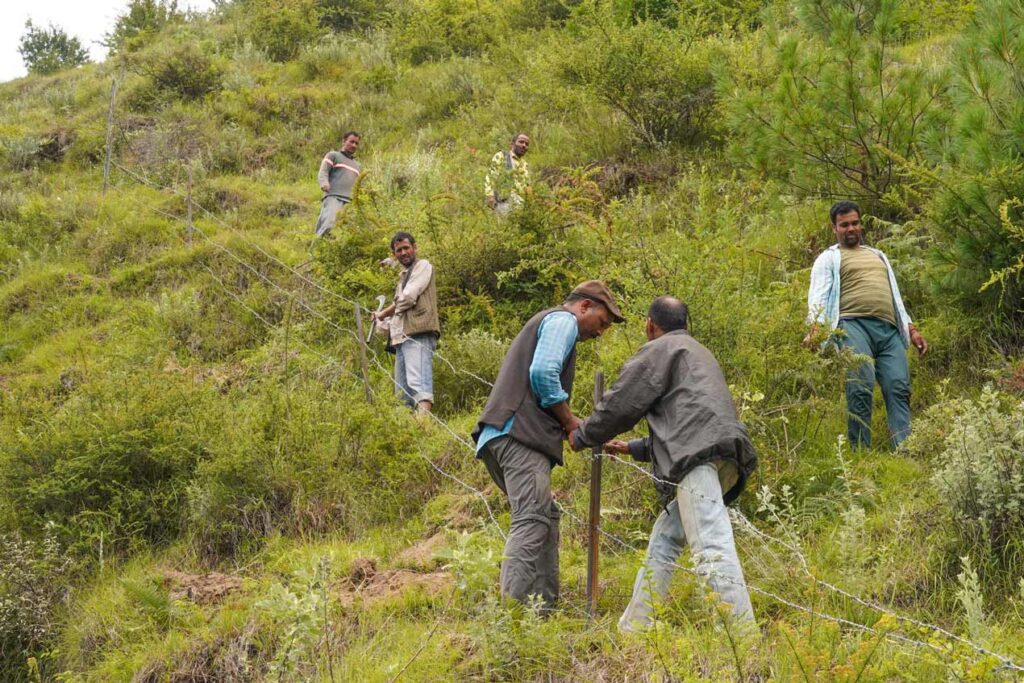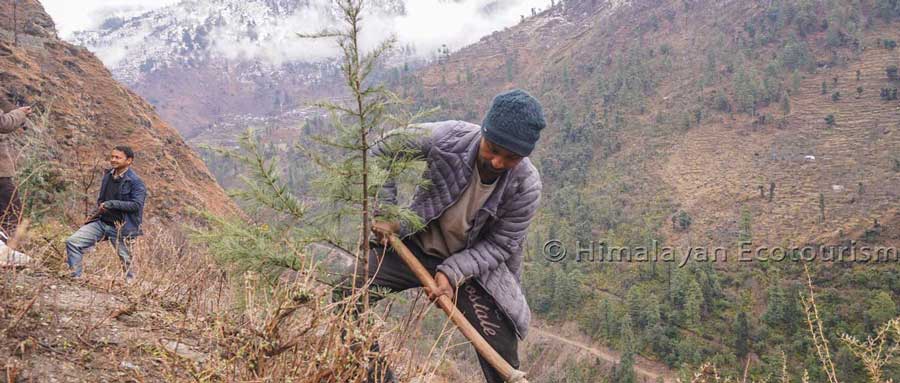Ecotourism as a way to promote conservation
By Sneha Harsh, published in the TerraGreen magazine of The Energy and Resources Institute (TERI)
Himalayan Ecotourism, a Social Enterprise
In the wake of catastrophic climate change, the term ‘ecotourism’ has become something of a catchphrase. It is everywhere, and often gives people a false sense of goodwill and responsibility. However, the ground reality shows a great discrepancy. There are only a handful of entities whose concern for the environment ultimately culminates into initiatives that make an impact.
Functioning in the remote Tirthan Valley of Himachal Pradesh, Himalayan Ecotourism is one such organization. When establishing the enterprise in 2014, Stephan Marchal, a founding member, had a singular vision in mind: to create a sustainable model of development in the Himalayas while preserving and regenerating its natural environment.
Operating under Himalayan Ecotourism, the GHNP Community-based Ecotourism Cooperative is a group of local villagers organizing treks and other outdoor activities in and near the Great Himalayan National Park (GHNP), as well as marketing and environmental experts. The logic behind their association is collaboration rather than competition, and economic self-reliance. With community and environmental welfare as their mission, Himalayan Ecotourism developed a way to utilize tourism business as the financial backbone of their social and conservation work.
What may be considered Himalayan Ecotourism’s greatest achievement is having instilled a sense of ecological responsibility where it was once lacking. The foundation of achievement lies in mutual trust, and it is the Himalayan Ecotourism’s commitment to personal interaction and financial transparency which ensures equal opportunities for growth in a space conducive to learning and creativity. Shivya Nath, a renowned travel writer from India, calls Himalayan Ecotourism the ‘only organization in the region based on fair-trade principles.’ On being shown the entire breakdown of costs for her trek, she felt that such transparency could revolutionize the travel industry. By implementing such business ethics, this social enterprise has brought people together for a cause, and into a system where the locals themselves are the initiators of change.
Their success, however, has not come easy. Navigating the lack of local administrative support and political tangles has proven to be difficult. Adding to that was the stiff competition from existing businesses which tried to bring their movement down.

What Really Worked in the Himalayan Ecotourism (HET) Model?
The initial motivation for the locals of the Tirthan Valley to join the movement was to benefit from employment opportunities through tourism. An economic incentive attracted the locals to the movement whereas the first social and environmental projects of HET originated from Stephan’s personal mission. The core members of cooperative society—the local people who took the lead in the movement—shyly participated in the early actions and did not become the initiators of the social projects until later on.
Women’s empowerment, development of green technologies and the problem of forest fires were the main focus of Stephan, besides promoting and operating the trekking business. Surprisingly, the first tangible impact of these actions was the drastic decrease of intentional forest fires in the Tirthan Valley and the GHNP which resulted from the ‘Stop Forest Fire’ campaign. The constant efforts to economically empower the local women and to introduce clean wood stoves and solar cookers did not receive the intended positive response from the local community. This was discouraging, however, simultaneously, the trekking business took off, enhancing the economic status of the cooperative members.
The real transformation took place when Himalayan Ecotourism was declared the overall winner of the Indian Responsible Tourism Award 2019. It was also recognized internationally as the winner of the Skal Sustainable Tourism Award 2019.
The core members of the cooperative society, whose awareness level is hyperlocal, suddenly realized that they had shaped an innovative and pertinent business model and as a consequence, they had been brought into the international spotlight. The five initial years of struggle in establishing the business finished with medals and awards and boosted their self-confidence highly. Members of the cooperative society began to believe that they could play an active role in the development of their villages. They could eventually conceive that any visible problem that affects their community can be addressed independently.
The degradation of the forest ecosystems in their valley is a reality that was seen earlier with fatalism, leading to no further thoughts and actions. That was no more true for the members of the cooperative after their socio-economic empowerment. From then, the vanishing forests were seen as a process that threatens their long-term well-being, and they decided to reverse the process by planting trees. A reforestation project was born as the initiative of the locals.
Since then, hundreds of trees have been planted, but at the same time, they realized that to be successful, they have to make their reforestation project, a community-approved and community-supported project. Stephan alone could not do this. The success of the Stop Forest Fires campaign was not because of the participation of the local community but was rather the result of a massive awareness movement in the pristine valley.
For the cooperative members, the next step was to spread their ideas and motivation from the level of their group to a broader community level, to ensure sustainability. Protecting their re-forested area from overgrazing, forest fires and other non-sustainable practices was the primary concern. Consequently, they went door-to-door explaining to the villagers the practices they can adopt to help them to preserve the newly planted trees. This strategy has proved to be very effective and has led to the cooperation of many villagers.
Moreover, as Keshav, the president of the cooperative society explained, ‘the only fact that the other villagers observe them engaged in a reforestation project strongly conveys a sense of sustainability among all other villagers.’ The motive is not just to plant trees but to create a movement within the community which will be repeated for decades to come and benefit future generations.
This is where the HET formula has proven to work; going beyond the dichotomy: locals versus outsiders. Bringing people from different horizons and cultures as well as bringing diverse sets of expertise together to trigger dynamics in the society which is otherwise reluctant to change. As a social activist interested in the global issues that threaten the future of the local community, Stephan attempted to steer the locals towards a sustainable way of living. However, this did not work until his local friends started to become the real actors of the process.
Considering the fact that a part of the fund goes to social projects and having limited human resources, the commitments of researchers, volunteers and interns from all over the world have made significant contributions to Himalayan Ecotourism’s mission. External supports and volunteers have become an integral part of the HET working culture. While the works of the volunteers serve the mission of HET, the organization nurtures them and develops their skills to navigate them towards a life of social entrepreneurship.











